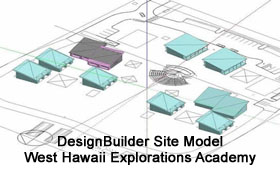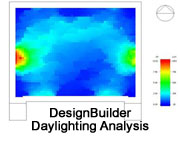
Ferraro Choi partners with UH Outreach College and School of Architecture’s Environmental Research and Design Lab
Ferraro Choi partners with UH Outreach College and School of Architecture’s Environmental Research and Design Lab (ERDL)
Ferraro Choi is partnering with the University of Hawaii’s School of Architecture’s Environmental Research and Design Lab (ERDL) to provide a real world platform for graduate and undergraduate students to implement building performance simulation software.
 The University of Hawaii Outreach College offers the course ARCH 692 – “Special Topics in Architectural Technology: Whole Building Energy Simulation.” This elective course is available to students in the School of Architecture program, engineering students and building professionals. The course was designed by Manfred Zapka, Kim Claucherty, Eileen Peppard and Somers Reid and supported by funding from an Oahu Workforce grant and the UH Hawaii Natural Energy Institute (HNEI). It is offered through the Environmental Lab that Steve Meder, Associate Professor of Architecture directs. The 16 week class and 8 week embedded practicum gives students and professionals opportunities for deepening their understanding of relevant building science fundamentals and to learn through “hands-on” experience with state-of-the-art building simulations tools that support metric-based climatic appropriate design.
The University of Hawaii Outreach College offers the course ARCH 692 – “Special Topics in Architectural Technology: Whole Building Energy Simulation.” This elective course is available to students in the School of Architecture program, engineering students and building professionals. The course was designed by Manfred Zapka, Kim Claucherty, Eileen Peppard and Somers Reid and supported by funding from an Oahu Workforce grant and the UH Hawaii Natural Energy Institute (HNEI). It is offered through the Environmental Lab that Steve Meder, Associate Professor of Architecture directs. The 16 week class and 8 week embedded practicum gives students and professionals opportunities for deepening their understanding of relevant building science fundamentals and to learn through “hands-on” experience with state-of-the-art building simulations tools that support metric-based climatic appropriate design.
Ferraro Choi is currently hosting Junghwa Suh, a graduate student in the School of Architecture’s Doctorate program who has obtained permission to perform research needed for her thesis by analyzing the building performance of the West Hawaii Explorations Academy project designed by Ferraro Choi. She will use building simulation software called “DesignBuilder“, a graphical user interface (GUI) to a simulation software called “EnergyPlus” that was developed by the U.S. Department of Energy (DOE). EnergyPlus is an open-source software (free of charge) that can be downloaded from the U.S. DOE website and is the “simulation engine” used by DesignBuilder.
 DesignBuilder provides building energy simulation, 3D model visualization, CO2 emissions, solar shading, natural ventilation, daylighting, comfort studies, CFD, HVAC simulation, pre-design, early-stage design, hourly weather data, heating and cooling equipment sizing.
DesignBuilder provides building energy simulation, 3D model visualization, CO2 emissions, solar shading, natural ventilation, daylighting, comfort studies, CFD, HVAC simulation, pre-design, early-stage design, hourly weather data, heating and cooling equipment sizing.
For the university, having an opportunity for a student to apply gained skills in a real world environment will bolster the relevance of whole building simulation to the practice of architecture and make a strong case for incorporation of such a program into the School of Architecture’s required curriculum and give talented students “face time” with working professionals.
For Ferraro Choi, having an opportunity to observe the application of a user-friendly whole building simulation tool could have great potential for future applications to inform the sustainable design process and strengthen an already recognized core expertise of the firm.
